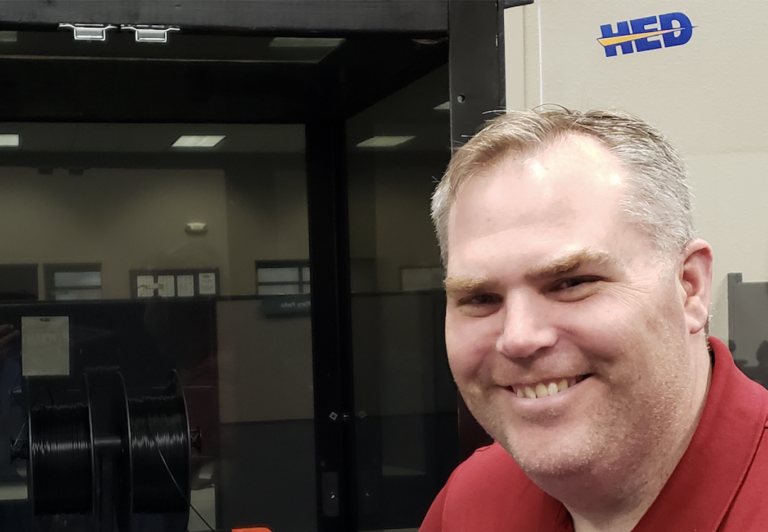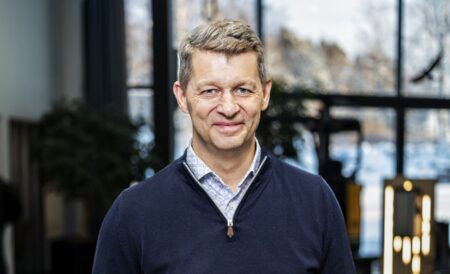When Matt Starr, an HED Inc. software engineer, returned home from the ConExpo trade show in Las Vegas in March he discovered he would be quarantined at home until further notice.
As the news about the COVID-19 pandemic became more unsettling, Starr felt he could make a contribution to support the challenges faced by the medical industry.
He began by pitching his idea to the CEO of HED, Paul Ludwig, suggesting that the company’s 3D printers could be used to create PPE protective masks for local Wisconsin medical facilities who are in desperate need of donations. Ludwig felt this was a great way for HED to contribute during this crisis. Matt immediately enlisted Jon Lobert, the HED mechanical engineer (pictured above) who is working from the HED office in Hartford, Wisconsin. Both began the project by learning what the National Institute of Health (NIH) requirements were for designing homemade protective facial masks.
To their relief, the requirements were pretty simple – it takes about an hour for one 3D machine to print two masks. Lobert works with two filament style 3D printers and has pretty much been creating masks non-stop since he and Starr began the project the first week in April.
To create the mask front shields, Lobert found clear folder covers commonly used in spiral bound presentations. “We happened to have a sizeable stack here at HED so I’m pulling from that to build the masks,” he said. “For now, I am making the face shields, but will be looking into also printing the clips that hold the conventional masks like the N95 type masks from rubbing against the wearer’s ears.”
While Lobert continues with production of the masks from HED, Starr is printing PPE components on his personal printer at his home.
HED has two 3D printers. A Lulzbot TAZ5 is their original machine the company has had for 5 years and a Prusa MK3S which is brand new and was put into service almost immediately when the company received it. For now, both machines are printing with a material called PLA that is approved by the NIH for these types of products.
“These face shields are meant to provide protection from aerosols landing on the face of the medical personnel. These aerosols can be droplets from coughs, sneezes, or worse and most likely would have the virus in them. This is part of the reason why it’s so bad to touch your face,” said Lobert.
“I have been printing on my own personal 3D printer, which is a Prusa i3 MK3S with MMU2S,” said Starr. “I started with a face shield design that is completely 3D printed except for the clear shield portion. It uses a baseball cap snap in the back to fit properly. Then I switched to the NIH approved design that Jon is printing. Now I am also printing respirator masks in conjunction with Concordia University in Mequon. Everything I am printing using PETG material since it is easier to disinfect and clean. It is also stronger and more flexible. I currently have 6KG of the material I am printing with.”
The face shield design that they both switched to does not require anything in the back to hold them in place. The support piece holds on similar to wrap-around sun glasses by applying pressure against the side of your head. The design initially came from Europe and was adapted to be made in the US using a 3-hole punch.
“The face masks I am making are being delivered to Concordia University and they are distributed based on need,” said Starr. “Concordia will finish the assembly by adding a silicone seal, filter material, and elastic to hold it to the face.”
In addition to the local hospitals, donations can be made to MatterHackers, an organisation who is coordinating a nationwide effort where companies like HED can ship face visors that are distributed to hotspots in need.
“A few HED employees are also reaching out to contacts like nurses and doctors that they know to see if they are in need and who we need to contact, ” said Starr.
Over the past weekend Matt Starr dropped off his first 20 face respirators and delivered 21 ear savers to a friend who knows a nurse at the Ascension Medical St. Mary’s Women’s Hospital NICU. “They mentioned that the masks they currently have to wear are held on by their ears and the straps were digging in. These ear savers should prevent that.”
On April 10th, it was reported by the Wisconsin Hospital Association that hospitals across the state are experiencing critically low levels of PPE for frontline workers. It was suggested that donations of PPE be made to the Tommy G. Thompson Youth Centre at the Wisconsin State Fair Park.





